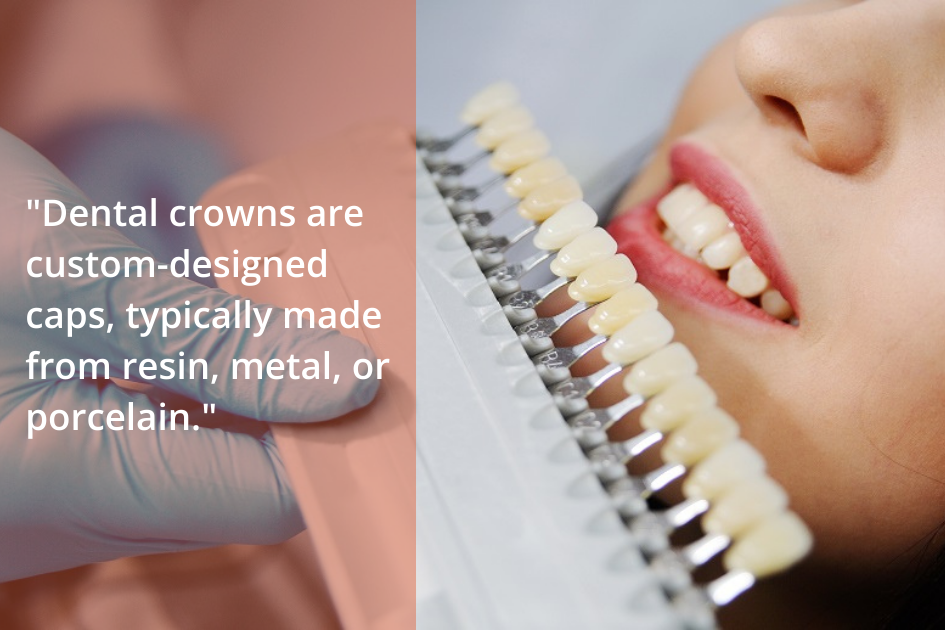Are you aware that dental crowns, made from various materials such as porcelain, can replicate the appearance and sensation of your natural teeth?
When exploring choices for repairing damaged or decayed teeth, it’s crucial to realize that dental crowns offer more than just functionality; they’re crafted to integrate flawlessly with your existing teeth, providing an added aesthetic appeal. They not only rejuvenate the shape, size, and durability of your teeth but also preserve their authentic look.
So, what’s the secret behind these dental restorations looking so similar to natural teeth? Stick around, and you’ll learn how dentistry combines art and science to make dental crowns almost indistinguishable from your real teeth.
Understanding Dental Crowns
Embarking on the exploration of dental crowns, it’s crucial to understand that these are custom-designed caps, typically made from resin, metal, or porcelain. They’re designed to restore the integrity and functionality of worn, broken, or decayed teeth. Dental crowns serve as a protective shell, covering compromised teeth and replicating natural teeth in both appearance and function.
Comprehension of dental crowns entails the recognition of various types available. Resin crowns are cost-effective but may wear over time; metal crowns, while durable, are more visible; porcelain crowns offer a balanced blend of durability and aesthetics. The selection depends on your personal preference and specific oral health requirements.
The creation of a dental crown generally requires two appointments. Initially, your dentist prepares the tooth, removes decay, and fits a temporary crown. The dentist then crafts the permanent crown based on an impression of your tooth. During your subsequent visit, this crown is checked for fit and bonded into place.
It’s noteworthy that advancements in CEREC technology now allow for the creation and placement of porcelain crowns in one visit, enhancing convenience and efficiency.
The Dental Crown Procedure
Undergoing a dental crown procedure involves several steps. Initially, the dentist prepares your damaged tooth by removing a small amount of enamel. This action creates space for the crown, which restores both the strength and appearance of your tooth. Dental crowns are crafted to imitate the function and aesthetics of natural teeth.
Resin, metal, or porcelain are typically used to create the crown. Your dentist selects the material considering your specific needs and preferences. The primary objective is to ensure that the crown isn’t only sturdy but also blends flawlessly with your natural teeth.
Subsequently, the dentist captures dental impressions of your prepared tooth. These impressions are vital as they direct the production of your custom-made crown, guaranteeing an impeccable fit. While your permanent crown is being prepared, a temporary one is used to safeguard your tooth.
Risks and Benefits of Crowns
Exploring the realm of dental crowns presents numerous advantages and a few potential hazards. Dental crowns, crafted to replicate natural teeth, have substantial benefits including treating damaged, broken or decayed teeth, enhancing chewing function, and upgrading your aesthetics.
The procedure for dental crowns usually covers two visits, which encompass tooth preparation, temporary crown placement, and the bonding of the final crown at the subsequent visit. This thorough process ensures a crown that operates and feels akin to a natural tooth.
However, it’s essential to be cognizant of the potential dangers associated with crowns. These comprise enamel removal, sensitivity, breakage or decay risk, and rare allergic reactions. Following the placement, you may experience problems such as a loose crown, unpleasant taste or breath, cracks or chips in the crown, and discomfort from sharp edges.
But, with adequate care, dental crowns can persist for up to 30 years. Refraining from hard nuts or sticky foods can prevent harm. Always seek advice from your dentist to comprehend the hazards and advantages of crowns and to choose the most suitable option based on your oral health requirements.
Recovery and Longevity of Crowns
Once a dental crown has been placed, it typically has a lifespan of 5 to 15 years, given regular oral care and dental visits. However, some crowns can last up to 30 years. The longevity of the crowns heavily depends on your personal habits and practices related to oral hygiene.
After the dental crown procedure is completed and the permanent crown is fitted, most individuals can return to routine activities instantly.
Post-procedure, it’s common to feel sensitivity and soreness for a few weeks. Over-the-counter pain relievers are often effective in managing this discomfort.
If you wish to extend the lifespan of your dental crowns, it would be prudent to steer clear of certain foods. Ice cubes, hard nuts, popcorn kernels, and sticky foods such as taffy and caramels have the potential to harm your crowns.
When to Consult Your Dentist
While dental crowns are built to be resilient and long-lasting, there could be instances where you may have to consult your dentist due to potential problems. These crowns are created to emulate the function of your natural teeth. However, similar to natural teeth, they can experience various issues.
Early recognition of any signs of trouble can significantly impact your mouth’s overall health.
A dental consultation should be scheduled if you encounter any of the following conditions:
- A sensation of looseness or instability related to the dental crown
- Unpleasant breath or taste around the tooth with the crown
- Visible damage such as cracks or chips in the dental crown
- Discomfort due to sharp edges from the crown
Persistent discomfort or pain in the region of the dental crown is a strong sign that you need to visit your dentist. It’s essential to remember that dental crowns are intended to emulate natural teeth in appearance and function; they aren’t supposed to cause continuous pain. Don’t hesitate to consult your dentist if you observe any changes or odd sensations. Prioritizing your dental health and addressing any potential problems early is always advisable.
Comparing Veneers and Crowns
Choosing between veneers and crowns involves understanding their distinct roles in dental restoration and aesthetics.
Veneers, thin porcelain shells, are crafted to mask the front surface of your teeth. They mainly tackle cosmetic problems such as chips, cracks, and stains.
Conversely, crowns, particularly those resembling natural teeth, envelop the entire tooth, enhancing its health and appearance. They serve more than just a cosmetic function, as they also address restorative needs, such as mending broken or decayed teeth that normal fillings can’t fix.
When comparing veneers and crowns, crowns deliver a more extensive coverage and protection. The procedure of fitting dental crowns includes the fabrication of a natural-looking replacement, inclusive of curves, cusps, and ridges, to harmonize flawlessly with your existing teeth. This is how dental crowns obtain a natural appearance and mimic your original teeth.
Natural Appearance of Dental Crowns
Dental crowns are meticulously designed to mirror the look of natural teeth. They incorporate features such as curves, cusps, and ridges to ensure a perfect blend and optimal function. These restorations, often made from porcelain or ceramic, are carefully formed and colored to match natural teeth.
Emphasizing a natural appearance, dental crowns provide:
- A range of shades to blend with your existing teeth
- Attention to variations in shape and size for an impeccable blend
- Utilization of materials like porcelain and ceramic to replicate the look and feel of natural teeth
- The choice of zirconia crowns, recognized for their toughness and lifelike appearance
While full metal crowns, such as those made of gold, are robust, they don’t offer the aesthetic appeal that porcelain or ceramic crowns do, which provide the most natural look. The goal is to restore your teeth’s function without sacrificing aesthetics.
Dental crowns not only improve your dental health but also enhance your smile by blending perfectly with your natural teeth.
Types and Materials of Crowns
Within the sphere of dental crowns, a wide range of types and materials are available, such as resin, metal, and porcelain, each with their specific advantages and considerations.
Metal crowns are recognized for their robustness and the minimal removal of enamel, making them a prudent choice for back teeth. Resin crowns, while cost-efficient, mightn’t have the longevity of other materials.
Porcelain-fused-to-metal (PFM) crowns, a hybrid sort, blend the robustness of metal with the aesthetically pleasing look of porcelain, rendering them suitable for both front and back teeth.
For those who’ve metal allergies or seek a more natural appearance, all-ceramic or porcelain crowns effectively imitate natural teeth by resembling tooth enamel. These crowns are specifically tailored to cover damaged teeth and function just like your natural teeth once installed.
Progress in CAD/CAM technology has enabled the production of same-day dental crowns. This technology removes the need for multiple clinic visits, providing a handy and efficient solution.
Grasping the types and materials of crowns aids in making a knowledgeable decision about your dental health. It’s crucial to remember that the objective of dental crowns is to replicate natural teeth, restoring both function and aesthetics to your smile.
Your Path to a Flawless Smile with Dental Crowns
Dental crowns could be your pathway to achieving a healthy, radiant smile. These are custom-made to mimic your natural teeth, providing strength, durability, and an appearance that’s virtually undetectable. CEREC technology allows for these to be placed in a single visit.
If you have broken, misshaped, or discolored teeth, or have had root canal treatment, porcelain crowns could be a consideration.
Don’t wait, reach out to Family Dental of Teravista, Georgetown, TX, today for a consultation and get ready to witness the transformation.













